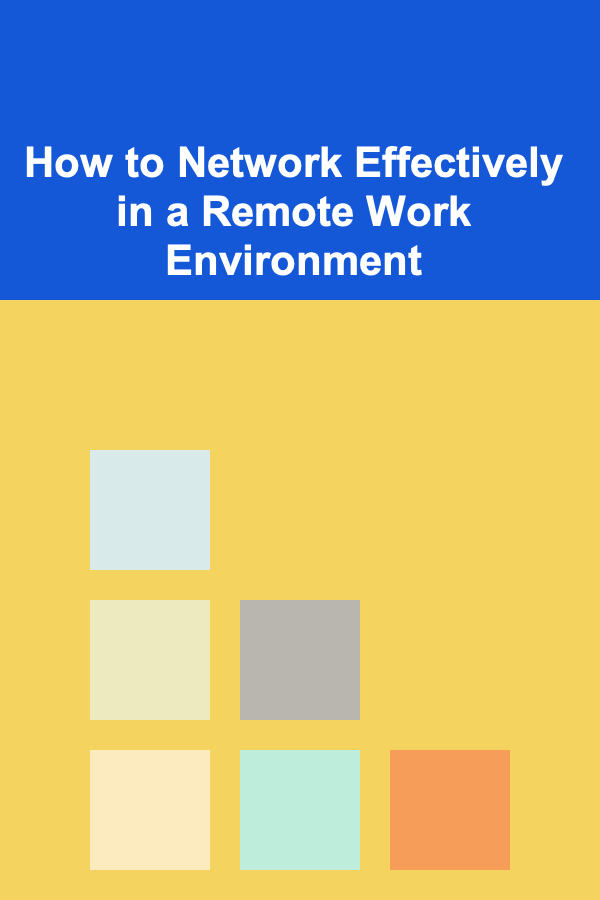
How to Network Effectively in a Remote Work Environment
ebook include PDF & Audio bundle (Micro Guide)
$12.99$6.99
Limited Time Offer! Order within the next:

Networking has long been regarded as a crucial element in advancing one's career, building professional relationships, and uncovering new opportunities. In a traditional office environment, networking often involves face-to-face interactions, water cooler chats, and spontaneous conversations in hallways or meeting rooms. However, with the rise of remote work, these informal networking opportunities are no longer as accessible. As more people work from home, the challenge of networking effectively in a virtual world has become a significant topic of interest.
In this actionable guide, we'll explore strategies for networking effectively in a remote work environment, leveraging digital tools, platforms, and techniques to build genuine relationships and further your professional growth.
Leverage Digital Platforms for Networking
The first step in networking effectively in a remote environment is utilizing the right digital platforms to connect with others. In a world where physical presence is no longer a given, virtual platforms serve as the backbone for all your professional interactions.
LinkedIn remains the premier platform for professional networking. It is an essential tool for expanding your professional network and discovering job opportunities, especially in the remote work sector. To make the most of LinkedIn, consider these actionable tips:
- Optimize Your Profile: Ensure your LinkedIn profile is up to date with a professional photo, detailed work experience, and an engaging summary that highlights your remote work skills.
- Connect and Engage: Start by connecting with colleagues, industry leaders, and even recruiters. Don't just send connection requests --- include a personalized message explaining why you'd like to connect.
- Engage in Discussions: Join relevant groups, participate in conversations, and comment on posts that resonate with you. Engaging regularly will increase your visibility and build relationships with like-minded professionals.
- Showcase Your Expertise: Publish articles or share insights related to your field to position yourself as a thought leader. Share success stories or tips on how to work remotely effectively.
Slack Communities
Slack has become a central hub for remote work communication, and there are numerous Slack communities dedicated to specific industries or interests. These communities are ideal for networking, as they allow you to engage with people who share your professional interests and goals.
- Join Relevant Slack Communities: Whether it's a community for tech professionals, remote workers, or digital marketers, find Slack groups where you can exchange ideas and opportunities.
- Engage Regularly: Don't just lurk --- participate actively. Introduce yourself, ask questions, share your experiences, and offer help when others are seeking advice.
- Direct Messaging: Use Slack's direct messaging feature to reach out to individuals for one-on-one conversations. Be polite, concise, and clear about why you're initiating contact.
Although Twitter is more casual than LinkedIn, it can still be a valuable tool for networking, especially in fast-paced industries like tech, marketing, or entrepreneurship. By following thought leaders and engaging in Twitter chats, you can connect with professionals and learn from their experiences.
- Follow Key Industry Figures: Follow people who inspire you, share knowledge, or work in the areas you're interested in.
- Use Hashtags: Participate in trending topics or niche discussions by using relevant hashtags (#remotework, #digitalmarketing, #techcareers). This is an excellent way to increase your visibility and connect with others in your field.
- Host Twitter Chats: If you want to take networking to the next level, consider hosting your own Twitter chat on a topic that excites you. This can position you as a community leader and attract others to connect with you.
Build Meaningful Relationships, Not Just Connections
Networking is not about collecting as many contacts as possible. In a remote environment, it's essential to focus on building meaningful, long-term relationships. Building rapport in the virtual world can be challenging, but it's far from impossible.
Personalized Communication
When reaching out to someone for the first time, be sure to personalize your message. A generic message won't stand out in someone's inbox, but a thoughtful and specific message can make a big difference.
- Mention Common Interests or Connections: If you share mutual interests, goals, or connections, highlight this in your message. It makes the interaction feel less transactional and more genuine.
- Be Clear About Your Intentions: Whether you're seeking advice, collaboration, or simply making a new connection, being transparent about your intentions helps set the tone for the conversation.
Schedule Virtual Coffee Chats
In a remote environment, it's easy to feel disconnected from people you haven't met in person. One of the best ways to overcome this is by scheduling virtual coffee chats or informal video calls. These one-on-one sessions allow you to build a personal connection and get to know the person behind the screen.
- Keep it Casual: A virtual coffee chat doesn't have to be an in-depth business meeting. Keep the conversation light, but professional. Ask about their background, how they got into their field, and what challenges they face in their work.
- Be Respectful of Time: Respect their schedule by keeping the meeting brief and to the point. If they're interested in continuing the conversation, they will reach out again.
Follow Up and Nurture Relationships
Networking doesn't stop once you've made a connection. Like any relationship, it requires nurturing and regular follow-ups. In a remote work environment, where you can't interact casually in the office, it's especially important to stay in touch.
- Follow Up After Initial Conversations: After a coffee chat or initial conversation, send a thank-you note to express appreciation for their time and insights.
- Share Helpful Information: Keep the conversation going by sharing articles, resources, or opportunities that may be of interest to them. This demonstrates that you're not just networking for your own benefit but also adding value to the relationship.
- Check-In Periodically: Reach out every few months to check in, offer congratulations on any new accomplishments, or share updates about your own professional journey.
Attend Virtual Networking Events
In a remote work environment, in-person events are often replaced by virtual events. These can range from industry-specific webinars and conferences to informal networking meetups. While virtual events might not provide the same casual vibe as physical events, they can still be an excellent opportunity to meet new people and learn from industry leaders.
Choose Relevant Events
Select virtual events that align with your career goals and interests. Attend conferences, webinars, or workshops hosted by organizations in your field. When you attend such events, make an effort to participate in the chat and ask questions during Q&A sessions.
Engage with Other Attendees
During virtual events, engage with other participants. Many events have designated networking sessions, chat rooms, or virtual "breakout" rooms where you can interact with others. Reach out to attendees whose work interests you or whose insights resonate with your goals.
- Be Active in the Chat: Engage with speakers and participants by asking questions or commenting during presentations.
- Use Event Platforms to Connect: Many virtual events have built-in tools for connecting with other attendees. Make use of these tools to schedule one-on-one chats with people you meet.
Follow Up Post-Event
After the event ends, follow up with the people you connected with. Mention something specific from your conversation to jog their memory, and express your interest in staying in touch. Networking events are a great way to build a base of connections, but the follow-up is what turns these initial interactions into lasting relationships.
Use Video Calls to Your Advantage
Video calls have become the go-to method for remote work communication, and they are invaluable for networking. Video calls allow for more personal and authentic interactions than emails or instant messages, and they help you stand out in a world where many remote workers rely on text-based communication.
Show Up with Professionalism
Even in a casual remote work environment, it's essential to be professional on video calls. Pay attention to lighting, dress appropriately, and ensure that your background is tidy and free from distractions.
- Test Your Equipment: Make sure your camera, microphone, and internet connection are working properly before the call begins.
- Maintain Eye Contact: Look into the camera while speaking to create a connection with the person you're talking to.
- Engage with Body Language: Non-verbal cues like nodding and smiling can help build rapport and show your engagement.
Build Stronger Relationships
Use video calls to build stronger relationships. Having face-to-face conversations (even virtually) fosters trust and a sense of connection, which is crucial when networking remotely.
- Ask Open-Ended Questions: Use video calls as an opportunity to learn more about the person you're speaking with. Ask open-ended questions that encourage them to share their experiences, challenges, and aspirations.
Stay Consistent and Be Patient
Networking in a remote work environment requires persistence and patience. It may take time to establish genuine relationships, and you may not see immediate returns on your networking efforts. However, consistency is key to successful networking.
- Set Networking Goals: Determine how many new connections you'd like to make each month or how many virtual coffee chats you want to schedule.
- Be Patient: Building meaningful relationships takes time, and not every connection will lead to immediate opportunities. However, over time, your network will grow, and you will have cultivated valuable connections.
Conclusion
Networking in a remote work environment can be challenging, but with the right tools, strategies, and mindset, it is possible to build meaningful relationships that will help you advance your career. By leveraging digital platforms, engaging in virtual events, and nurturing relationships with regular follow-ups, you can effectively network remotely. Remember, networking is not just about what others can do for you, but about creating lasting, mutually beneficial connections. With consistency and patience, you'll be able to establish a robust professional network that supports your growth, no matter where you're working from.

How to Choose the Best Appliances for Your Home Renovation
Read More
How to Design an Entryway that Reflects Your Personal Style
Read More
How to Negotiate Your Salary for Better Financial Security
Read More
How to Scale Your Property Management Business for Growth: An Actionable Guide
Read More
How to Stage Your Home for a Family-Friendly Appeal
Read More
How to Preserve Delicate Materials in Collage Art
Read MoreOther Products

How to Choose the Best Appliances for Your Home Renovation
Read More
How to Design an Entryway that Reflects Your Personal Style
Read More
How to Negotiate Your Salary for Better Financial Security
Read More
How to Scale Your Property Management Business for Growth: An Actionable Guide
Read More
How to Stage Your Home for a Family-Friendly Appeal
Read More